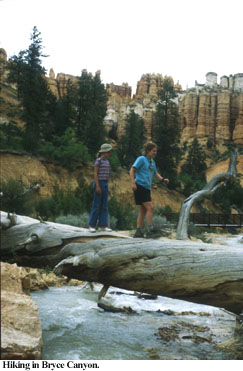|
|
 By
Golden Webb
By
Golden Webb
The Mormon homesteader Ebenezer Bryce called it “a helluva place to lose a cow.” The Paiute Indians, who lived in and around Bryce Canyon for centuries, named it Unka-timpe-wa-wince-pock-ich—“Red rocks standing up like men in a bowl-shaped recess.” To 19th Century geologist Clarence Dutton, the Bryce Amphitheater seemed “the work of giant hands, a race of genii once rearing temples of rock, but now chained up in a spell of enchantment, while their structures are falling in ruins through centuries of decay.” For novelist Willa Cather, places like Bryce were the “bright edges of the world”—wide-open spaces, usually in the desert Southwest, where the air had a “peculiar quality . . . Something that lightened the heart, softly, softly, picked the lock, slid the bolts and released the prisoned spirit of man, into the wind the blue and gold, into the morning.” To the million or so visitors it receives each year Bryce Canyon National Park is all of these things—and much, much more.
I’m standing in the mountain wind at Yovimpa Point, the southernmost stop on the paved park road. Technically, Bryce Canyon isn’t a canyon at all: it’s what the locals call a “break”—the crumbling edge of a level upland. Here the eastern rim of the 9,000-foot-high Paunsaugunt Plateau falls away in a serie of spectacularly eroded amphitheaters (called the Pink Cliffs) to the Paria River basin. The view from the rim carries the eye past brilliantly colored hoodoos, obelisks, fairy spires and columns to distant humpbacked domes: the barrier cliffs of the Lower Paria River. Directly below me The Promontory drops into the heart of the badlands; pale white along the brink, the earth flares a sudden orange below the first line of cliffs, with striations of red and tawny peach on the smooth siltstone slopes. Above my head the sky is clear and blue, but summer clouds build on the southeast horizon, piling into massive thunderheads over the slickrock spine of the Cockscomb. “It is a country of long views,” writes Edward Geary, “a spacious country, yet the horizon, however distant, is always clearly defined, the ridgelines providing a proper edge to the immensity of the sky.”
A lofty perch like this offers a kind of glimpse into eternity—a vista that reaches, inch by inch, all the way back to the Jurassic. The whole of the Colorado Plateau has been thrust more than a mile vertical mile above sea level, but here on its northwest slope massive blocks fissured along fault lines have risen higher still (and continue to rise). The Paunsaugunt Plateau makes up one of these blocks, a great sky-island capped by limestones, shales, and siltstones that have disappeared elsewhere from the region—stripped away long ago by the slope-wash of rain, ice and wind. But where these rocks remain, they form the archetype of High Plateaus scenery: rugged breaks, a fairlyland of crumbling hoodoos. At Bryce Canyon along the Paunsaugunt Plateau, and Cedar Breaks on the Markagunt, the earth serves notice that she’s going to tell her story and tell it well, hinting at further glories downstream—at Zion, in the Paria, and within the depths of the Grand Canyon.